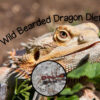There are many fascinating facts about bearded dragons, here are some of them. These laid-back lizards, known for their docile temperament and distinctive throat scales resembling a beard, are frequently chosen as pets.
The genus Pogona, are a diverse group that thrives in the variable landscapes of their homeland, from deserts to subtropical woodlands. Their popularity has only grown as hobbyists explore the range of hues and shapes that selective breeding within captivity can achieve.
Although they are often found basking in the serene wilderness of Australia, pet bearded dragons are known for their remarkable behaviors, such as the ability to recognize their caregivers and respond to being handled with leash-like restraints.
One of the most interesting facts about bearded dragons is that their adaptability extends to their biology, as they possess the unique capability to adjust their sex based on incubation temperatures. Moreover, these reptiles have adapted to the harshness of their environment with peculiar traits, such as excreting concentrated urine to conserve water. Whether navigating the wild or dwelling in the controlled enclosures of caregivers, these “gentle dragons” can live substantial lives for a small reptile, spanning up to a decade in the wild and even longer when cared for in captivity.

Jump To…
11 Fun Facts About Bearded Dragons
1. Bearded Dragons Have Venom
Bearded dragons possess venom, but it’s mild and not harmful to humans. Found in both their upper and lower jaw glands, this venom is vestigial, meaning its original purpose has diminished over time. Mainly used to subdue small prey, the venom’s impact on humans is negligible. Bites from bearded dragons are rare, as they are generally passive and avoid conflict. If bitten, the concern is more about bacterial infections like salmonella rather than venom.
2. They Can Change Color
- Rapid Color Shifts: Bearded dragons exhibit a swift change in skin coloration that can reflect their emotional state.
- Display of Emotions: The color shift towards black particularly around their throat is indicative of stress, aggression, or excitement.
- Posture Changes: Accompanying color changes, they may puff themselves to appear larger and display spines along their chin.
- Social Interaction: These visual signals play a critical role in communication, conveying submission or dominance during encounters.
- Resting State: When at peace, their throat color stabilizes, matching their overall body color.
3. Bearded Dragons can Regenerate some of their Teeth!
More amazing facts about Bearded dragons is their remarkable dental trait—they are capable of regenerating their polyphyodont teeth, a feature they share with creatures like sharks and geckos. These renewable teeth are predominantly found at the front of their mouths. However, not all of their teeth share this regenerative ability. For instance, acrodont teeth, once lost, do not replenish.
- Polyphyodont Teeth: Can regenerate over time.
- Acrodont Teeth: Non-regenerative; permanent loss if fallen.
This distinct feature underscores their evolutionary adaptation for survival, balancing both renewable and permanent teeth on their jawline.
4. Female Bearded Dragons Can Store Sperm For Later Use
A look at interesting facts about bearded dragons breeding, how about storing sperm! Female bearded dragons exhibit a notable reproductive adaptation: they can store sperm internally after a singular mating event.
During the breeding period, these stored sperm cells can be utilized to fertilize multiple egg clutches. A female bearded dragon can lay between 11 and 30 eggs per clutch, potentially resulting in two clutches each season without the need for additional mating encounters. This efficiency in reproduction is beneficial as it reduces the frequency of mating, a process which can become aggressive, with males often biting females.
Males, on the other hand, are capable of producing sperm continuously throughout the year. The ability of females to retain sperm lessens the requirement for frequent contact with their male counterparts, which may become contentious due to the males’ violent tendencies during copulation. Bearded dragons reach sexual maturity by age one or two, commencing their reproductive capabilities.
5. Gestural Communication in Bearded Dragons
Bearded dragons communicate using a variety of gestures. Besides head bobbing for dominance or mating, arm waving for submission, they exhibit other behaviors. Tail wagging can indicate curiosity or agitation, while gaping (opening the mouth) might be for temperature regulation or territorial display. They also perform glass surfing, possibly indicating stress or a need for more space. Color changes, especially in the beard, can signal stress, aggression, or temperature regulation. Understanding these behaviors is crucial for interpreting their social interactions, mood, and overall well-being.
6. Temperature-Induced Gender Shifts in Bearded Dragons
Still more facts about bearded dragons, how about temperature-induced sex reversal! This is a phenomenon in bearded dragons where high incubation temperatures can cause male embryos to develop into females. Specifically, male embryos exposed to temperatures surpassing 96.8 degrees Fahrenheit may transform into females.
These thermally induced females, known as trans females, are fertile and can lay significantly more eggs than genetically female bearded dragons. This unique adaptation is believed to have potential implications for their survival in changing climates. A key scientific study that discusses this phenomenon was completed by Holleley, O’Meally, Sarre, Marshall Graves, Ezaz, Matsubara, Zhang & Georges (2015).
This research provides valuable insights into the impact of environmental factors on the sex determination process in reptiles, specifically bearded dragons, and its potential evolutionary significance.
7. Bearded Dragons Can’t Cough!
Facts about bearded dragons lungs leads us to, like other reptiles, they don’t have a diaphragm! The diaphragm is a muscle that mammals use for breathing. In mammals, the diaphragm plays a crucial role in the mechanics of coughing. In reptiles, breathing is typically facilitated by movements of the ribs and muscles in the body wall.
Here’s a more detailed explanation:
- Role of the Diaphragm in Coughing: In mammals, the diaphragm is a critical muscle for respiration. During a cough, the diaphragm contracts sharply, creating a rapid influx of air into the lungs. This is followed by a sudden, forceful exhalation that helps expel irritants or mucus from the respiratory tract. The diaphragm’s ability to rapidly contract and relax is key to this process.
- Respiratory Anatomy of Reptiles: Reptiles, including bearded dragons, lack a diaphragm. In reptiles, breathing is primarily facilitated by the movement of the ribs and muscles associated with them, rather than a diaphragm. This rib-based breathing mechanism does not allow for the sharp, forceful exhalation that is characteristic of a cough.
- Consequences of No Cough Reflex: The absence of a cough reflex in reptiles like bearded dragons means that they cannot effectively expel mucus or other substances from their lungs and airways. This can make them more susceptible to respiratory infections and complications, as they cannot clear their respiratory tract as efficiently as mammals can.
In summary, the inability of bearded dragons to cough is due to their unique respiratory anatomy, specifically the absence of a diaphragm, which is essential for the cough reflex in mammals. This anatomical difference has significant implications for their respiratory health and the management of respiratory conditions.
Ways a bearded dragon may rely more on mucociliary clearance (the movement of mucus by cilia in the respiratory tract) to remove debris and pathogens. However, this system is generally less efficient than coughing.
Respiratory infections can be more challenging to treat, as the reptile cannot assist in clearing its own airways. Veterinary interventions may include manual or mechanical assistance to clear the respiratory tract, along with medical treatments.
8. Bearded Dragon Can Sleep For Months: Brumation
During colder months, bearded dragons enter a dormant state known as brumation. This phase is akin to hibernation, typically commencing when temperatures drop. In their native habitat of Australia, this period aligns with the Australian winter starting in June.
Characteristics of brumation include:
- A gradual decline in energy levels
- Reduced appetite
- Extended periods of sleep
Throughout this time, a bearded dragon’s metabolic processes slow significantly to minimize energy expenditure.
9. Bearded Dragons Climb Trees
Facts about bearded dragons in the wild: they climb trees! Bearded dragons are semi-arboreal. While they are often found on the ground, they are proficient climbers and spend a significant portion of their time in bushes and low-lying trees. Here’s how these reptiles navigate their semi-arboreal habitats:
- Habitat Preferences: They favor environments that provide a blend of terrestrial and elevated perches, such as branches and boulders, which offer basking areas and lookout points for predators and prey.
- Physical Adaptations: Their strong limbs and clawed feet aid in grasping and climbing, a necessity for a lifestyle that includes both ground and elevated spaces.
Additionally, their climbing ability has direct implications for their overall well-being:
- Behavioral Enrichment: Climbing offers mental and physical stimulation, which is crucial for their health in captivity. It is recommended that enclosures include appropriate climbing structures to mimic their natural semi-arboreal tendencies.
- Thermoregulation: By shuttling between sunny spots and shade in their three-dimensional environment, they are able to effectively regulate their body temperature throughout the day.
In conclusion, bearded dragons are not exclusively terrestrial and their inclination to climb should be considered both in understanding their behavior in the wild and in providing optimal care for them in captivity.
- Habitat Adaptations: Bearded dragons display adaptability in their habitats, often climbing to elevated perches.
- Behavioral Traits: They ascend trees for various reasons, such as:
- Acquiring food that’s not available on the ground.
- Escaping from predators.
- Seeking sunlight for thermoregulation.
- Demonstrating social dominance by positioning above others.
10. Interesting Facts About Bearded Dragons Hearts
An interesting fact about bearded dragons hearts is that, unlike mammals, they have a three-chambered heart instead of four. This unique heart structure consists of two atria and one partially divided ventricle which allows for some separation of oxygenated and deoxygenated blood.
Additionally, as ectothermic creatures, their heart rate and overall metabolism are highly influenced by environmental temperatures, slowing down in colder conditions. This adaptation is particularly evident during their hibernation-like state known as brumation, where their heart function undergoes significant changes to accommodate a lower metabolic rate.
11. Bearded Dragons Have a Third Eye
Did you know that a bearded dragon’s third eye, also known as the parietal eye, can detect changes in light and dark even when their eyelids are closed? This unique feature helps them stay alert to potential threats even while they rest, making them excellent at staying safe in their environment.
Facts About Bearded Dragons: Conclusion
In conclusion, the array of facts about bearded dragons underscores the remarkable and diverse nature of these reptiles. From their unique venomous capabilities to their ability to undergo temperature-induced gender shifts, bearded dragons continue to fascinate reptile enthusiasts and researchers alike.
Their adaptability, evident in their ability to conserve water through concentrated urine excretion and their distinctive heart structure, highlights their evolutionary prowess. Additionally, the insights into their respiratory system, particularly their inability to cough due to the absence of a diaphragm, further demonstrate the distinct physiological differences between reptiles and mammals.
These facts about bearded dragons not only enhance our understanding of these creatures but also enrich the experience of caring for them as pets. Whether observed in the wild or in captivity, bearded dragons offer a unique window into the complex and intriguing world of reptilian life.
References
Amey, A. P., & Whittier, J. M. (2000). The annual reproductive cycle and sperm storage in the bearded dragon, Pogona barbata. Australian Journal of Zoology, 48(4), 411.
Capraro, A., O‘Meally, D., Waters, S. A., Patel, H. R., Georges, A., & Waters, P. D. (2020). MicroRNA dynamics during hibernation of the Australian central bearded dragon (Pogona vitticeps). Scientific Reports, 10(1).
Collar, D. C., Schulte, J. A., O’Meara, B. C., & Losos, J. B. (2010). Habitat use affects morphological diversification in dragon lizards. Journal of Evolutionary Biology, 23(5), 1033–1049.
Fry, B. G., Vidal, N., Norman, J. A., Vonk, F. J., Scheib, H., Ramjan, S. F. R., Kuruppu, S., Fung, K., Blair Hedges, S., Richardson, M. K., Hodgson, Wayne. C., Ignjatovic, V., Summerhayes, R., & Kochva, E. (2005). Early evolution of the venom system in lizards and snakes. Nature, 439(7076), 584–588.
Holleley, C. E., O’Meally, D., Sarre, S. D., Marshall Graves, J. A., Ezaz, T., Matsubara, K., Azad, B., Zhang, X., & Georges, A. (2015). Sex reversal triggers the rapid transition from genetic to temperature-dependent sex. Nature, 523(7558), 79–82.
News, O. H. C. (n.d.). Central Bearded Dragon. The Australian Museum.
Salomies, L., Eymann, J., Khan, I., & Di-Poï, N. (2019). The alternative regenerative strategy of bearded dragon unveils the key processes underlying vertebrate tooth renewal. ELife, 8.
Stumpel, J., Benato, L., & Eatwell, K. (2012). Transcutaneous pulmonoscopic removal of intrapneumonic mucus in a bearded dragon (Pogona vitticeps). Veterinary Record, 170(13), 338.1-338.





